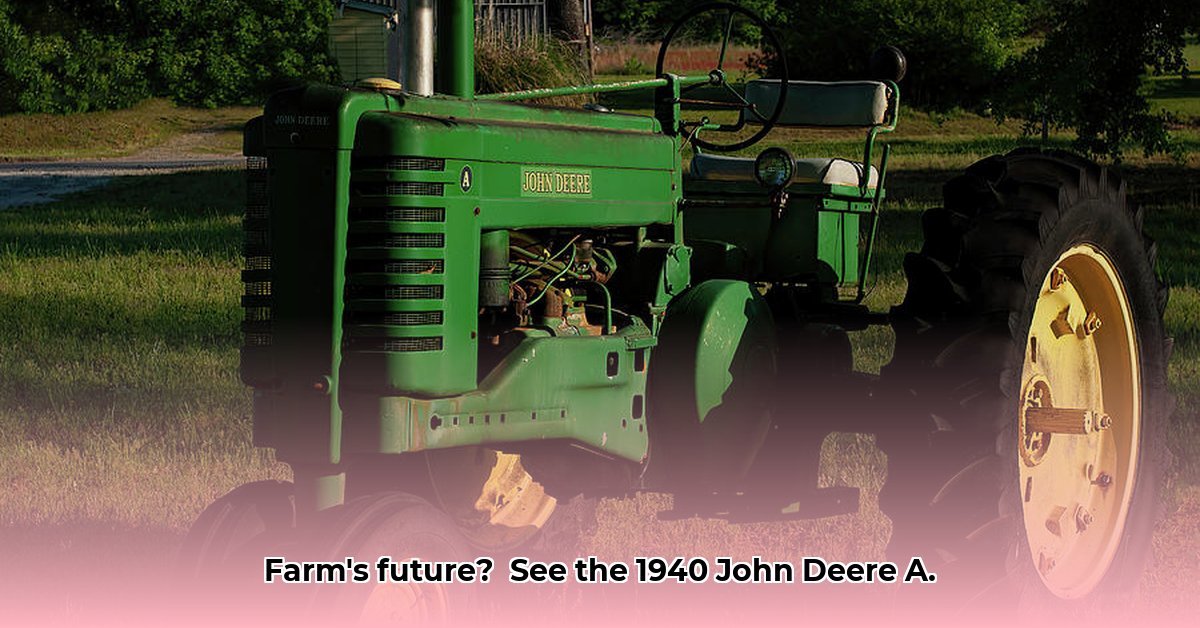
The year is 1940. Across the American heartland, the familiar rhythm of horse-drawn plows was slowly being replaced by a new sound: the rumble of the John Deere Model A tractor. This machine, a marvel of engineering for its time, wasn't just another piece of farm equipment; it represented a seismic shift in agricultural practices, forever altering the landscape of farming and impacting the lives of countless farmers. Over 300,000 Model A tractors were produced, a testament to their widespread adoption and the profound impact they had on agricultural productivity. But how does this iconic machine stand up to modern notions of sustainability? For more detailed information, see the Model A specs.
A Look Back: The Agricultural Context of 1940
Before the Model A, farming was backbreaking work. Farmers relied on manual labor and animal power, resulting in low yields and intense physical demands. The Great Depression had further exacerbated these challenges, leaving many farmers struggling to make ends meet. Mechanization offered a lifeline, promising increased efficiency and the potential for greater food production. The Model A stepped into this environment, offering a tangible solution to these long-standing difficulties.
The Model A: Technical Innovation in the Field
The 1940 John Deere Model A's revolutionary features were a direct response to the hardships faced by farmers. Its most significant innovation was the use of rubber tires, a departure from the steel wheels of previous tractors. This seemingly small change dramatically improved traction, reducing soil compaction and improving crop yields. Less soil compaction directly translates to healthier soil and less damage to the land—a key component of sustainable farming practices, even by today's standards.
The Model A's two-cylinder gasoline engine, while less fuel-efficient than modern counterparts, provided the horsepower needed to tackle a wide range of farming tasks. This increased efficiency allowed farmers to accomplish more in less time, streamlining operations and potentially freeing up time for other tasks. Its rugged design and relative simplicity made it a reliable and durable workhorse crucial to the efficient functioning of farms.
Sustainability: A Nuanced Perspective
Assessing the Model A's sustainability using today's metrics presents a challenge. While it wasn't a zero-emission machine, its contribution to sustainability is more nuanced than a simple carbon footprint calculation. The increased efficiency it provided directly reduced the energy expenditure of human labor, a significant factor that shouldn't be overlooked. This is a crucial point that must be explored when investigating its role in the context of agricultural sustainability.
Furthermore, the reduced soil compaction from its rubber tires contributed to improved long-term soil health. However, the increase in agricultural production facilitated by the Model A also led to changes in farming practices that, in retrospect, we now understand have negative environmental consequences. The widespread expansion of monoculture farming practices, for instance, increased dependency on chemical fertilizers and pesticides—impacts that were not initially well understood.
The Model A's Environmental Footprint: Data Limitations and Interpretations
Precise data on the Model A's fuel consumption and emissions are scarce. However, its widespread adoption indicates it represented a significant improvement in agricultural efficiency for its time. Further research could potentially provide more granular data on specific aspects of its environmental impact, however we must acknowledge the limits of the data that is available to us. Its influence, however, is undeniable, not only in its immediate impact, but also in its role as a precursor to the continuous evolution of agricultural technology.
A Lasting Legacy and the Future of Agriculture
The 1940 John Deere Model A's legacy isn't solely about a single machine. It embodies the larger narrative of agricultural innovation, reflecting humanity's consistent drive to improve farming practices. By examining its successes and limitations, we can gain invaluable insights into the ongoing effort to balance productivity with environmental responsibility in modern agriculture. The Model A’s story compels us to consider: how can we continue to advance agricultural technology while minimizing environmental impact? What lessons can be learned from past innovations to shape the future of sustainable farming?
Summarizing the Model A's Impact: Benefits and Drawbacks
| Feature | Positive Impact | Potential Negative Impact |
|---|---|---|
| Mechanization | Significantly increased farming efficiency; reduced labor demands | Increased reliance on fossil fuels (gasoline) |
| Rubber Tires | Improved traction; less soil compaction; potentially better yields | Accelerated the adoption of large-scale farming methods |
| Engine Technology | Provided sufficient power for its time; relatively reliable | Relatively low fuel efficiency by modern standards; emissions |
| Overall Impact | Revolutionized farming; increased food production | Potentially contributed to soil degradation and biodiversity loss in the long-term |
The 1940 John Deere Model A tractor's story highlights the intricate relationship between technological advancement and sustainability. Its legacy reminds us of the ongoing conversation about feeding the world responsibly while minimizing environmental impacts — a conversation that is critical and ever-evolving.